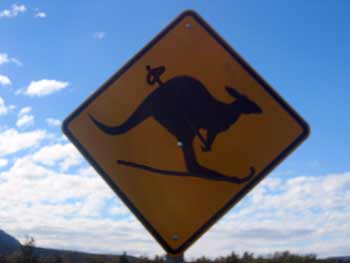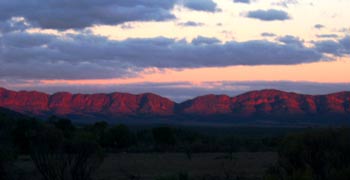Spotting (and Avoiding) the Kangaroos in Flinders Ranges
9th July, Port Augusta, Australia
From Port Augusta we took a drive north to Flinders Ranges this morning. I knew we wouldn't get to see all of it, given that it stretches some 400km north of Spencer Gulf (upon which Port Augusta sits), but with good roads leading far into the heart of the ranges, we could be guaranteed to see (arguably) the best of it.
I made a note of the various towns that we would pass on the way, expecting to turn off at each one for some form of sight-seeing or other, but instead ended up driving straight through the towns of Quorn and Hawker, ignoring the potential attractions of Yourambulla Caves (we'd done the whole limestone caves thing to death already in Sydney and Waitomo, NZ) or the historical interest of the Pichi Richi railway. We did, however, make endless stops at the roadside to catch photos of the ever-changing (due to changes in the weather/lighting) ranges to our left and right. Every time I pulled over, I would snap a photo fully expecting to get an even better one just five minutes up the road. To say this was a stop-start kind of drive would not be exaggerating.
Arkaroo
Rock, Flinders Ranges.
We ploughed on as far as a place named Wilpena Pound. It may sound like a dog kennel, but you're more likely to find kangaroos and emus here. In fact, in the last few kms outside of the National Parks Visitor Centre I think I saw more kangaroo road-kill per 100m than anywhere. This was a roo graveyard on a grand scale, but I was relieved that's all it was. If that sounds heartless, I'll explain why: a few miles back up the road I had been driving at around 60km/h and as I glanced over to the left I saw a human skeleton. "Shit!" I let out, quite understandably, then pulled over in something of a hurry. I ran back down the road, wondering how long it had been there and how nobody had seen it yet, or if they had why it had not been reported to the authorities. The answer came soon enough - nobody reported it because they'd look a bit stupid calling a kangaroo skeleton 'human remains'. Jeez, I was relieved. It was amazing, though, just how human it had looked at 60km/h - all kangaroo-like shapes and fur had long been removed by carrion, leaving only the skeleton and just about enough connective tissue to give it some form. It was the way that the long legs were stretched out straight that gave the skeleton a human adult's height and dimensions. I got back in the van and happily reported to Manda what I'd found.
Clever kangaroos they have in the Flinders Ranges. You really gotta watch
out for the snowboarding ones though, they're even more radical. Dude.
From Wilpena Pound, the roads are pretty basic - unsealed and only good for high speed in a modern car with good shock absorbers. Still, we soldiered on through some extremely bumpy rough tracks that shook our (nearly) 30-year-old kombi left, right and centre. Sometimes the unsealed roads would change from being a smooth, water-sculpted finish to a corrugated-iron finish within metres. Unfortunately, the groove of these corrugated sections was always perpendicular to our direction of travel. Equally unfortunate was the fact that we'd always find these viciously 'groovy' sections when we were doing something like 30km/h.
Rattled bones aside, it was worth venturing off the bitumen and deeper into the park because we got to see lots of kangaroos (there's always something more special about seeing them in the wild, and not in a zoo or sanctuary) and even some wild emus; we also saw some (apparently rare) yellow-footed rock wallabies. The most comical thing about these kangaroos is the way they all stop whatever they are doing and just stare at you, perhaps twitching an ear back, but not really moving much. They know that they are safe, but occasionally I'd hop (no pun intended) out of the van and pretend to chase them, just to get some movement out of them - well, what's the point of using a camcorder if they are just gonna stay still?!
Pretending to chase the 'roos gets them to do something more interesting
than simply looking at you blankly, chewing and twitching an ear.
We left Wilpena Pound just before our 5pm 'curfew' (see previous entry for the low-down on that) and were treated to some spectacular colours on one of the ranges as the sun just dipped out of view, momentarily bathing the hills in a vivid red shade. No sooner had we taken a couple of photos than the colour drained away for another day.
The Chase Range at sunset.
Now all we had to do was get to a caravan site without harming Skippy or one of his distant relatives.



